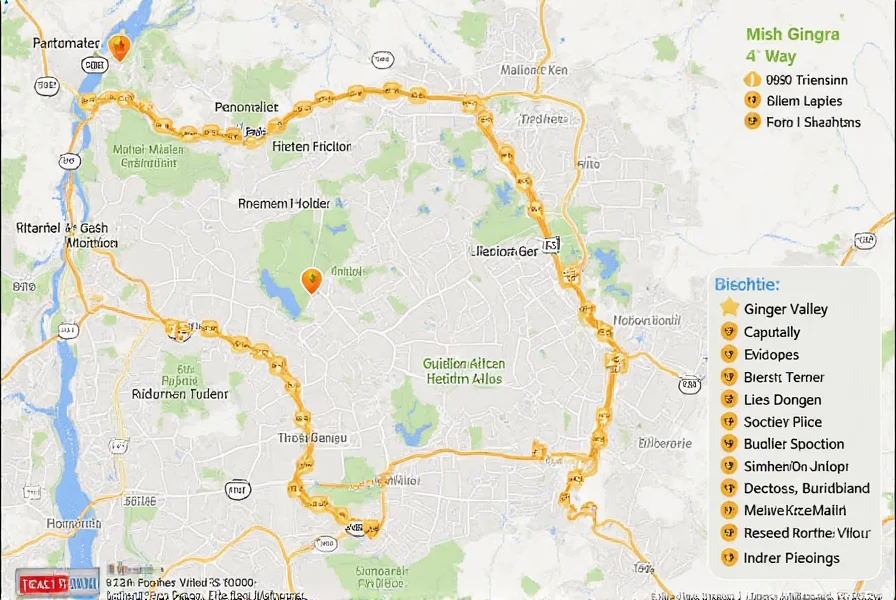Understanding the geographical and historical context of Ginger Valley provides valuable insight into this quiet Pennsylvania community. Unlike major tourist destinations, Ginger Valley represents the authentic rural character of central Pennsylvania, offering a glimpse into the region's natural beauty and settlement patterns.
Geographical Location and Features
Ginger Valley occupies a distinctive position within Perry County's landscape. Situated at approximately 40°27′12″N 77°18′24″W, the area features rolling terrain characteristic of the Ridge-and-Valley Appalachians. The community centers around Ginger Valley Road, which follows the course of Ginger Valley Run, a tributary of Sherman Creek.
The area's elevation ranges from 600 to 1,200 feet above sea level, creating varied microclimates that support diverse plant life. This topography explains why early settlers named the area after the wild ginger (Asarum canadense) that thrives in the moist, shaded conditions along the valley's waterways.
| Feature | Details |
|---|---|
| County | Perry County, Pennsylvania |
| Nearest Major Town | Newport, PA (15 miles southeast) |
| Nearest City | Harrisburg, PA (25 miles south) |
| Geographical Region | Ridge-and-Valley Appalachians |
| Water Feature | Ginger Valley Run (tributary of Sherman Creek) |
Historical Development
The history of Ginger Valley dates back to the late 18th century when European settlers first established homesteads in the area. Early land records from Perry County, established in 1820, document the valley's presence as a recognized geographical feature.
Unlike many Pennsylvania communities that developed around specific industries, Ginger Valley remained primarily agricultural. The valley's rich soil supported small family farms that cultivated crops and raised livestock. Historical maps from the 1870s show several farmsteads along what is now Ginger Valley Road, indicating established settlement patterns by the post-Civil War era.
The origin of the name "Ginger Valley" appears in multiple historical accounts referencing the abundance of wild ginger plants. Early settlers used the plant for both culinary and medicinal purposes, contributing to the valley's distinctive identity. Unlike some Pennsylvania place names with clear documented origins, Ginger Valley's naming likely emerged organically from local usage rather than official designation.
Community Characteristics Today
As an unincorporated community, Ginger Valley lacks formal municipal boundaries or government. The area maintains its rural character with a low population density. Current residents primarily live on properties ranging from small homesteads to larger acreages, preserving the agricultural heritage while accommodating modern lifestyles.
The community falls within the Greenwood School District, with students attending schools in nearby Newport. Local governance occurs through Bloomfield Township, which handles zoning, road maintenance, and other municipal services for the area.
While Ginger Valley doesn't have commercial centers or public facilities within its immediate boundaries, residents benefit from proximity to Newport's amenities while enjoying the privacy and natural surroundings of the valley. The area's peaceful environment attracts those seeking rural living without complete isolation from essential services.
Natural Environment and Outdoor Activities
Ginger Valley's location within Pennsylvania's Appalachian region offers abundant natural features. The surrounding forests consist primarily of mixed hardwoods including oak, maple, and hickory, with rhododendron thickets along waterways. Wildlife commonly observed in the area includes white-tailed deer, wild turkey, and various songbirds.
Outdoor enthusiasts appreciate Ginger Valley's proximity to recreational opportunities. Sherman Creek provides fishing access for trout and smallmouth bass, while the adjacent state game lands offer hiking, hunting, and wildlife observation. The valley's elevation changes create varied hiking experiences, from gentle valley walks to more challenging ridge-line treks.
Seasonal changes dramatically transform the landscape, with vibrant fall foliage attracting visitors from surrounding areas. Spring brings wildflower displays along the valley's streams, including the namesake wild ginger with its distinctive heart-shaped leaves and maroon flowers.
Visiting Ginger Valley
Those planning to visit Ginger Valley should understand its character as a residential rural area rather than a tourist destination. The community welcomes respectful visitors interested in experiencing authentic Pennsylvania countryside.
Access to Ginger Valley occurs via Ginger Valley Road from PA Route 333. Visitors should note that many properties are privately owned, so exploring requires respecting posted boundaries. The best approach involves using public roads for scenic drives while appreciating the valley's natural beauty from designated areas.
For those interested in the region's history, the Perry County Historical Society in New Bloomfield maintains archives documenting the area's settlement and development. Nearby Newport offers dining and shopping options for visitors exploring the Ginger Valley area.
Frequently Asked Questions
Where exactly is Ginger Valley located in Pennsylvania?
Ginger Valley is located in Bloomfield Township, Perry County, Pennsylvania. It sits approximately 15 miles northwest of Newport and 25 miles north of Harrisburg, within the Ridge-and-Valley Appalachians region of central Pennsylvania.
What is the origin of the name Ginger Valley?
The name comes from the wild ginger plants (Asarum canadense) that historically grew abundantly along the streams and forested areas of the valley. Early settlers used these plants for culinary and medicinal purposes, leading to the valley's distinctive name through common usage.
Is Ginger Valley an official town or municipality?
No, Ginger Valley is an unincorporated community, meaning it has no formal municipal boundaries or local government. It exists as a recognized geographical area within Bloomfield Township, Perry County, with residents falling under township governance.
What recreational activities are available near Ginger Valley?
The area offers hiking on nearby state game lands, fishing in Sherman Creek for trout and smallmouth bass, wildlife observation, and seasonal foliage viewing. The valley's elevation changes provide varied terrain for outdoor enthusiasts while maintaining proximity to Newport's amenities.
Can visitors explore Ginger Valley?
Yes, visitors can access Ginger Valley via Ginger Valley Road from PA Route 333. However, as a residential rural area, visitors should respect private property boundaries. The best approach involves using public roads for scenic drives while appreciating the natural beauty from designated areas.











 浙公网安备
33010002000092号
浙公网安备
33010002000092号 浙B2-20120091-4
浙B2-20120091-4